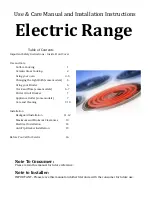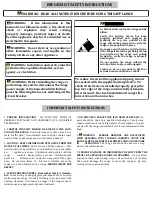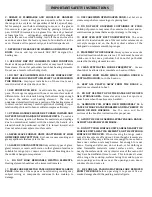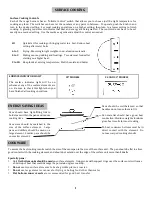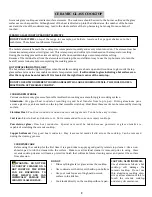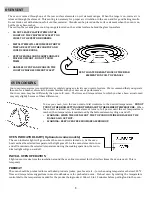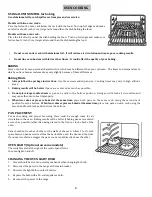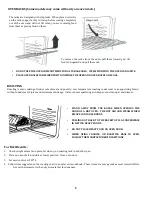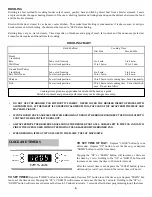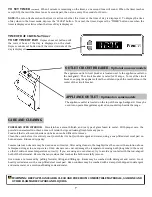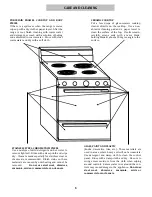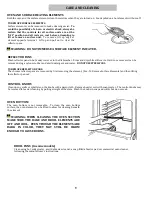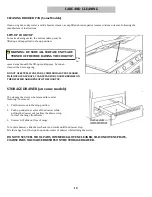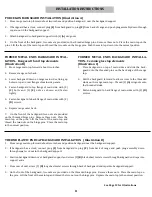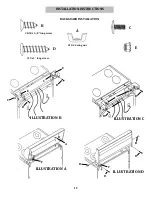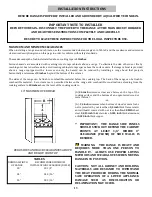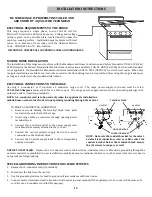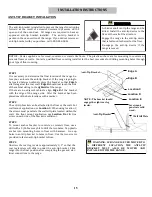
8. GREASE IS FLAMMABLE AND SHOULD BE HANDLED
CAREFULLY. Avoid letting grease deposits collect around
the range or in vent fans. Let quantities of hot fat, a pan of deep
fat for example, cool before attempting to move it. If a grease
fire occurs in a pan, put out the flame by placing a lid on the
pan. DO NOT throw water on a grease fire. Use a dry chemical
or foam type fire extinguisher. extinguisher. If a fire should
occur in the oven or while broiling, turn off the oven, close the
oven door and allow the food or grease to burn itself out in the
oven. If smoke or fire persist, call your local fire department.
9. NEVER USE THE RANGE FOR WARMING OR HEATING THE
ROOM. Ovens and top elements ARE NOT designed for
heating use.
10. USE ONLY DRY POT HOLDERS IN GOOD CONDITION.
Moist or damp potholders on hot surfaces may result in burns
from steam. Do not let potholders touch hot heating elements.
Do not use a towel or other bulky cloth.
11. DO NOT USE ALUMINUM FOIL TO LINE SURFACE UNIT
DRIP BOWLS OR OVEN BOTTOMS EXCEPT AS DESCRIBED IN
THIS MANUAL. Improper installation of these liners may
result in a risk of electric shock, or fire.
12. USE PROPER PAN SIZE. Avoid unstable, easily tipped
pans. This range is equipped with one or more surface units of
different size. Select utensils having flat bottoms large enough
to cover the surface unit heating element. The use of
undersized utensils will expose a portion of the heating element
to direct contact and may result in ignition of clothing. Proper
relationship of utensil to burner will also improve efficiency.
13. UTENSIL HANDLES SHOULD BE TURNED INWARD AND
NOT EXTEND OVEN ADJACENT SURFACE UNITS– To reduce
the risk of burns, ignition of flammable materials, and spillage
due to unintentional contact with the utensil, the handle of a
utensil should be positioned so that it is turned inward, and
does not extend over adjacent surface units.
14. NEVER LEAVE SURFACE UNITS UNATTENDED AT HIGH
OR MEDIUM HEAT SETTINGS. Boil-over causes smoking and
greasy spillovers that may start a fire.
15. GLAZED COOKING UTENSILS-Only certain types of glass,
glass/ceramic, ceramic, earthware, or other glazed utensils are
suitable for range-top or oven service without breaking due to
the sudden change in temperature.
16.. DO NOT SOAK REMOVABLE HEATING ELEMENTS.
Heating element should never be immersed in water.
17. MAKE SURE REFLECTOR PANS OR DRIP BOWLS ARE IN
PLACE. Absence of these pans or bowls during cooking may
subject wiring or components underneath the cooktop to
damage.
18. USE CARE WHEN OPENING OVEN DOOR. Let hot air or
steam escape before removing or replacing food.
19. DO NOT HEAT UNOPENED CONTAINERS OF FOOD.
Buildup of pressure may cause the container to burst and re-
sult in serious personal harm and/or damage to the range.
20. KEEP OVEN VENT DUCT UNOBSTRUCTED. The oven
vent duct is located under one of the rear surface elements on
coil style ranges and on the front vertical surface of the
backguard on ceramic smooth top ranges.
21. PLACEMENT OF OVEN RACKS. Always place oven racks
in desired location while oven is cool. If rack must be moved
while oven is hot, use a pot holder but do not let pot holder
contact hot heating element in oven.
22. CLEAN VENTILATING HOODS FREQUENTLY. Grease
should not be allowed to accumulate on hoods or filters.
23. SHOULD FOOD FLAME WHEN COOKING UNDER A
VENTILATING HOOD, turn the hood on.
24. KEEP ALL PLASTIC AWAY FROM THE RANGE as
plastics are vulnerable to heat.
25. DO NOT USE THE TOP OF THE RANGE OR THE OVEN
AS A STORAGE AREA. Items stored can melt or ignite or
cause burns when those items are handled.
26. ALUMINUM FOIL WHEN USED IMPROPERLY IS A
CAUSE OF MANY RANGE PROBLEMS AND MAY RESULT IN
SHOCK OR FIRE HAZARDS. See the oven and broil
sections of the book for instructions for proper use.
27. AVOID THE USE OF AEROSOL SPRAYS NEAR A RANGE,
AS MOST ARE HIGHLY FLAMMABLE.
28. DO NOT TOUCH SURFACE UNITS, AREAS NEARBY THE
SURFACE UNITS, HEATING ELEMENTS, OR THE INTERIOR
SURFACE OF THE OVEN. When cleaning the range, make
sure all elements are off and cool. Even though elements are
dark in color, they may still be warm enough to cause burns.
Areas near surface units may become hot enough to cause
burns. During and after use, do not touch, or let clothing or
other flammable materials contact surface units, areas
nearby the surface units, or any interior area of the oven until
they have had sufficient time to cool. This includes all areas
of the range, the cook-top, surfaces facing the cook-top, oven
vent openings and surfaces near the openings, oven doors,
window of oven doors, etc.
29. BE SURE ALL PACKING MATERIALS ARE REMOVED
FROM THE RANGE before operating it to prevent fire or
smoke damage should the packing material ignite.
IMPORTANT SAFETY INSTRUCTIONS

